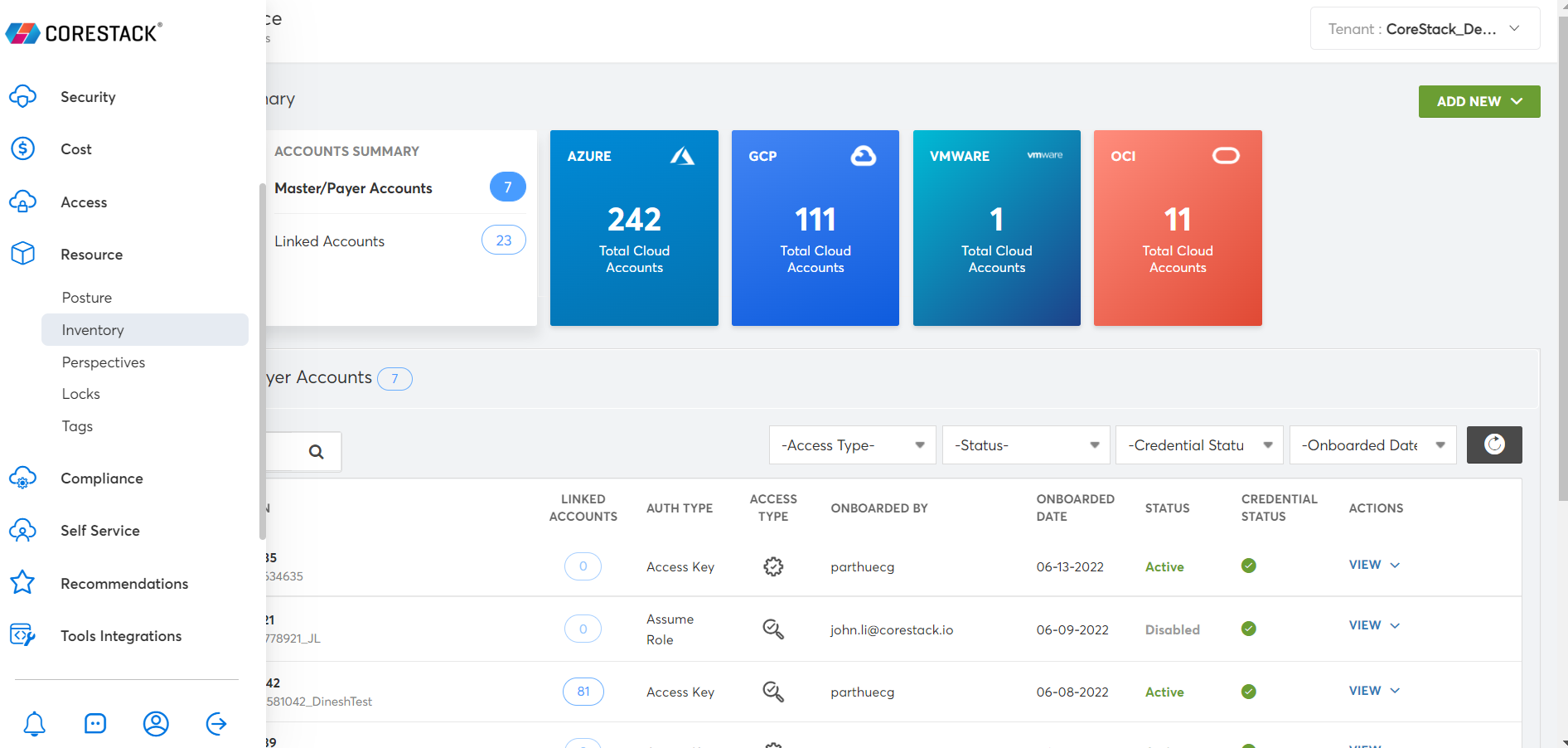Inventory
Introduction
Cloud discovery and inventory management tools are a key part of being well-prepared to handle modern day cloud inventory management needs. They can help to gain full visibility of cloud resources and computer networks across an organization, in turn providing opportunities to improve customer satisfaction, decrease costs, and optimize service levels and working capital investment.
By using a connector-less model, CoreStack makes it easy to discover cloud services across multiple cloud providers -- and CoreStack’s cloud resource inventory feature maintains a customer's cloud inventory items (along with category) across platforms, accounts, regions and regional groups.
These two powerful functions, along with governance-related features, can help make the CoreStack platform a core component of any multi cloud strategy.
Navigating Inventory Management
Follow the below steps to access different cloud inventory views in CoreStack:
- Login to CoreStack, then select Resource > Inventory in the nav menu.

-
Select a provider in the Cloud Services filter (e.g. AWS, Azure, OCI).
-
In the Cloud Accounts filter, select the desired cloud account(s).
-
Select the relevant resource category in the Category filter
(In the below example screenshots, the set category is Compute.)
After the data is done loading, the page will display an updated list of cloud resource types under the selected category in the left section of the page, and a table view of all the resources of a selected type on the right side of the page.
Note:
As of version 3.8, there are two new column views available: Created Time and Changed Time.
Additional Actions for Resources
To access additional actions and view more specific details for a particular resource, click on that resource's row in the table view. The available options for that resource should appear below it.
Depending on the resource, these options can include:
Utilization
Select this option to view the utilization details for a cloud resource (needs to be active for at least 12 hours prior).
Relationships
Select this option to view any other cloud resources related to the one selected.
Audit Log
Select this option to view the activity log for a particular cloud resource.
Actions
Select this option to expand a list of additional inventory actions for a cloud resource:
- Delete: Delete an inventory action.
- Manage Tags: Change tag key and tag value.
- Reset: Reset an inventory action.
- Soft Reset: Clear entire inventory data.
- Start: Start tracking inventory action.
View Resource Rules
Select View under the Rules column to view or download the rules for a particular cloud resource.
The rules should display the following inbound and outbound information:
| Communication Type | Fields |
|---|---|
| Inbound/Outbound | - Name - Access - Direction - From Port - To Port - Priority - Source - Destination - Protocol |
View Resource Tags
Next, click View under Tags to view the tags for a particular resource.
Note:
Tags enable you to categorize your cloud resources in several ways, such as purpose, function, owner, or environment.
Consequently, when you use the cloud inventory manager in CoreStack to collect metadata from an instance, it also collects the tag information attached to that instance, making the tag information available as part of the inventory metadata of the instance.
This allows customers to filter or query inventory metadata based on the instance categorization represented by tags. For example, you can choose to query your inventory only for the instances in a production environment.
After clicking View under Tags, the tag information for that resource should appear in a pop-up on the page.
Search an Inventory
To search information related a specific resource in your discovered cloud inventory, type the information in the search box and press Enter.
You can also copy the information under a respective field and paste it in the search box, then press Enter.
Updated 6 months ago